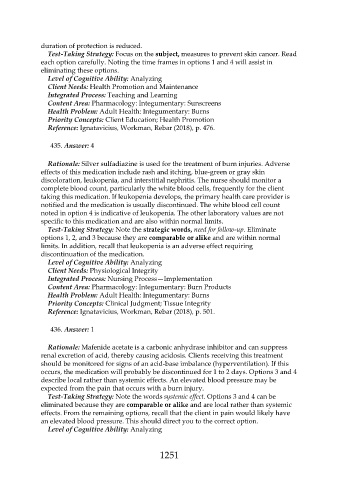Page 1251 - Saunders Comprehensive Review For NCLEX-RN
P. 1251
duration of protection is reduced.
Test-Taking Strategy: Focus on the subject, measures to prevent skin cancer. Read
each option carefully. Noting the time frames in options 1 and 4 will assist in
eliminating these options.
Level of Cognitive Ability: Analyzing
Client Needs: Health Promotion and Maintenance
Integrated Process: Teaching and Learning
Content Area: Pharmacology: Integumentary: Sunscreens
Health Problem: Adult Health: Integumentary: Burns
Priority Concepts: Client Education; Health Promotion
Reference: Ignatavicius, Workman, Rebar (2018), p. 476.
435. Answer: 4
Rationale: Silver sulfadiazine is used for the treatment of burn injuries. Adverse
effects of this medication include rash and itching, blue-green or gray skin
discoloration, leukopenia, and interstitial nephritis. The nurse should monitor a
complete blood count, particularly the white blood cells, frequently for the client
taking this medication. If leukopenia develops, the primary health care provider is
notified and the medication is usually discontinued. The white blood cell count
noted in option 4 is indicative of leukopenia. The other laboratory values are not
specific to this medication and are also within normal limits.
Test-Taking Strategy: Note the strategic words, need for follow-up. Eliminate
options 1, 2, and 3 because they are comparable or alike and are within normal
limits. In addition, recall that leukopenia is an adverse effect requiring
discontinuation of the medication.
Level of Cognitive Ability: Analyzing
Client Needs: Physiological Integrity
Integrated Process: Nursing Process—Implementation
Content Area: Pharmacology: Integumentary: Burn Products
Health Problem: Adult Health: Integumentary: Burns
Priority Concepts: Clinical Judgment; Tissue Integrity
Reference: Ignatavicius, Workman, Rebar (2018), p. 501.
436. Answer: 1
Rationale: Mafenide acetate is a carbonic anhydrase inhibitor and can suppress
renal excretion of acid, thereby causing acidosis. Clients receiving this treatment
should be monitored for signs of an acid-base imbalance (hyperventilation). If this
occurs, the medication will probably be discontinued for 1 to 2 days. Options 3 and 4
describe local rather than systemic effects. An elevated blood pressure may be
expected from the pain that occurs with a burn injury.
Test-Taking Strategy: Note the words systemic effect. Options 3 and 4 can be
eliminated because they are comparable or alike and are local rather than systemic
effects. From the remaining options, recall that the client in pain would likely have
an elevated blood pressure. This should direct you to the correct option.
Level of Cognitive Ability: Analyzing
1251

